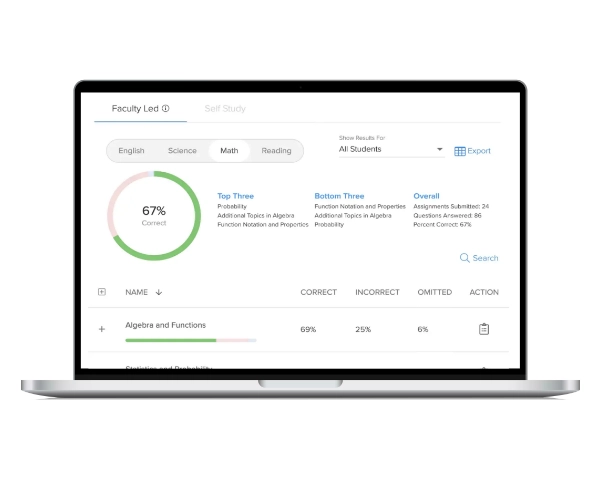What’s a question worth?
Most teachers would agree that teenagers love sharing their opinion, even when unsolicited. That’s why asking probing questions is one of the most effective ways teachers can stimulate intelligence and creativity in K-12 students. In some ways, it’s speaking their language. However, promoting and sustaining critical thinking in K-12 students requires that teachers move beyond simply asking the right questions.
Students also need to understand how their thought processes in answering questions may be effective or ineffective and why their responses may be right or wrong. This understanding leads to concept mastery—the essence of learning. Concept mastery is achieved through students not just answering questions correctly by guessing but by understanding how they arrived at an answer and why they are absolutely correct.
Mastery is the difference between knowing a definition and actually understanding the concept behind the definition and how and when it applies. Once a student can recognize why a thought pattern or process led them to an outcome, whether correct or incorrect, they will develop a sense of discernment in approaching future questions. That’s where “the why” shows its actual value.
That said, developing the right questions to promote critical thinking is a very time-consuming effort that requires lots of planning and prep time. New teachers, in particular, struggle with this because it is an acquired skill, with experience being the best teacher.
Why “the why” matters!
Critical thinking begins when a student asks “why” after answering a question wrong: Why is my thought process flawed? Why did my strategy not work? Why is the correct answer correct, and why are the other choices wrong? Such reflective questions compel students to think critically. When students are presented with the opportunity to review explanations to their answer choices, they will unlock their ability to understand concepts instead of simply memorizing correct answers.
Detailed explanations of correct and incorrect answers help students master concepts by teaching them how to think. Once they understand the rationale for an answer choice, they will know how to independently arrive at the right solution.
Knowing the details of why an answer choice is correct or incorrect helps students better navigate their way to the correct answer when presented with a different question testing the same concept, e.g., on midterms, final exams, or standardized tests like the SAT® and ACT®. This is known as formative or explanatory feedback.
What does the research say?
A consensus exists in the education research community that formative feedback and retrieval practice are essential components of the learning process. Decades of research provide compelling evidence that formative feedback and retrieval practice result in the following:
- Improve learning and skill development
- Enhance student motivation to learn
- Are effective across a range of subject areas
- Improve the retention of information
How does formative feedback help students?
Formative feedback, which is information communicated to the student intended to modify their thinking or behavior, improves learning, skill development, and motivation to learn. Research on feedback has shown positive effects across various subjects. One study involving over 6,000 students learning to improve reading comprehension revealed that those who received feedback had better outcomes than those who did not. Other studies have shown that feedback positively impacts learning in the sciences, social sciences, math, and history.
How does retrieval practice benefit students?
Retrieval practice refers to students’ attempts to recall and apply previously learned knowledge or skills after a period of forgetting. When combined with feedback, the results are powerful. Empirical research in cognitive science has concluded that when students can connect retrieval practice with feedback, they learn and retain information more effectively. Retrieval practice boosts learning by extracting information from students’ minds (critical thinking) instead of cramming information into their heads (lectures).
This integration of feedback with retrieval practice enhances learning by enabling students to discern what they know from what they don’t know—a thought process known as metacognition or understanding about their own thought process. In simpler terms, metacognition is thinking about how you think.
When combined with retrieval practice, feedback negates students’ tendency to become overconfident, so they don’t falsely think they remember or understand concepts when they do not, per se. Another benefit of retrieval practice is helping students navigate making mistakes and correcting them, improving the learning experience.
What other kinds of feedback are helpful to students?
Elaborated feedback in practice, where students are provided with an explanation for correct or incorrect answers, has also proven effective. When tested against other feedback methods in a computer-based learning environment, elaborated feedback was more effective than knowledge of results and knowledge of correct response. This shows that having in-depth explanations of the rationale for an answer is more helpful to students than simply knowing the correct or incorrect answers.
Does the timing of feedback matter?
The timing of feedback also makes a difference in learning, retention, and academic success. While both immediate and delayed feedback deliver positive results, researchers have found that immediate feedback is more effective than varied feedback. The results of several studies revealed that immediate feedback increases retention, accuracy at identifying initial responses, and confidence in response identification while simultaneously reducing repeated incorrect answers.
Other studies show that feedback provided to students seeking to improve their reading comprehension skills was more effective if given directly after reading versus during the reading or much later. Students also tend to prefer immediate feedback over delayed feedback and are more likely to spend more time reading immediate feedback than delayed.
However, both immediate and delayed feedback give students a learning advantage and different merits on when teachers should use them. Some researchers have concluded that immediate feedback is appropriate for verbal and procedural skills, while delayed feedback is appropriate for learning a simple task or transferring learning to new situations.
What methods of feedback are most effective in learning?
Computer-based learning environments have become increasingly popular over the past few decades as a means for providing feedback to students instead of one-to-one teacher-led instruction. While evidence suggests that one-to-one instruction has the advantage of adapting to the student’s needs, it is not necessarily feasible in K-12 education.
Researchers concluded that computer-based systems could help meet individualized learning needs by leveraging systems that feature practice questions, timely feedback, and automated scoring. They also determined that computer-delivered feedback was more effective in learning reading comprehension skills than human feedback, recommending systems that delivered feedback directly after reading.
The primary advantage of computer-based feedback is that students perceive it as objective and unbiased, meaning they are likely to trust the input.
How can teachers best deliver quality feedback to students?
Researchers have provided some guidance for educators to use in delivering effective feedback, including:
- Use elaborated feedback to address the topic, the response, or specific error(s). Address the what, how, and why of the problem.
- Make sure feedback is specific, clear, and concise.
- Clarify learning goals, acknowledge progress, and identify measures needed to reach goals.
- Offer unbiased, objective feedback. Computer-based feedback is perceived as impartial.
- Provide feedback after students have attempted a solution.
How do UWorld’s College Readiness Learning Tools align with the research?
1. Backed by science.
This research governs why we engage students in an interactive learning process at UWorld. When using our learning tools, students first attempt to answer a question (or several questions) before receiving helpful, informative feedback on all answer choices. This constructive feedback explains the problem’s what, how, and why, teaching students to understand the concepts in-depth.
Formative feedback has informed how we design technology-enhanced college readiness tools for the SAT and ACT exams and AP® courses to enhance retrieval practice. Our elaborated, explanatory feedback, automated scoring, and detailed reporting enable students and teachers to determine the next steps in continuing their learning.
We embed the informative feedback process in our detailed explanations with vivid illustrations for all our content, structured as follows with subtle variations based on the subject. See the example for AP U.S. History below:
- Annotations included with the images are used to provide context while keeping the explanation concise. For example, an explanation’s annotations may identify historical figures that might be unrecognizable to a modern audience. They also help explain how students should interpret the image.
- The remainder of the correct answer explanation presents historical background context to clarify how and why the image relates to the correct answer. The sentence containing the phrase in bold type connects the explanation to the language of the question and the right answer choice.
- Blue text in the explanation of the correct choice signals hyperlinks to images or definitions, giving additional context for students unfamiliar with the terms—without lengthening the top-level explanation or interrupting the flow for students who already understand the terms.
2. Designed for effective retrieval practice.
Our tools are designed to supplement classroom instruction to help students retrieve facts, concepts, and skills previously taught and allow them to apply this learning to new contexts. Students choose a subject or specific topic they want to review and practice questions on that subject. Informative feedback reinforces content they have learned before, enabling students to resolve misunderstandings and avoid repeating mistakes the next time they study the material.
3. Feature a variety of helpful, elaborated feedback.
Where appropriate, our feedback covers the topic, thoroughly explaining the question’s terminology to help students identify precisely what the question is asking. Plus, our feedback is specific to each response choice.
Explanations offer a detailed but concise explanation of the correct answer, providing background on the question, connections to the prompt or question stem, and additional context where needed. This thorough feedback helps students quickly identify the how and the why of the correct answer choice.
The incorrect answer choice feedback will also address the specific error the student has made, helping students fill in knowledge gaps or correct misunderstandings. Our Things to remember feature provides students with a final note about the most vital information to remember about the topic.
The Verdict
Ultimately, the abundance of scientific evidence and our almost two decades of experience preparing students for success in high-stakes exams have strengthened our conviction in our methodology. When it comes to K-12 education, understanding the how and the why through research-based explanatory feedback makes all the difference in fostering successful learning outcomes.
References
IESD Research Paper. What Research Says About Promoting Learning Through Retrieval Practice with Formative Feedback. August 2020. UWorld College Readiness IESD Research Paper.




